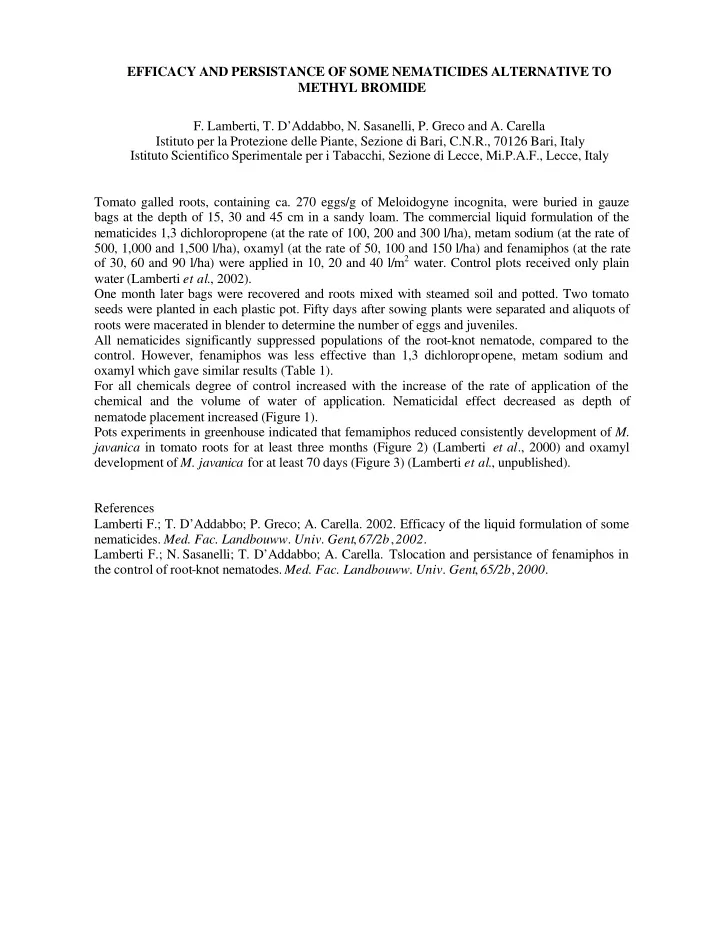

EFFICACY AND PERSISTANCE OF SOME NEMATICIDES ALTERNATIVE TO METHYL BROMIDE F. Lamberti, T. D’Addabbo, N. Sasanelli, P. Greco and A. Carella Istituto per la Protezione delle Piante, Sezione di Bari, C.N.R., 70126 Bari, Italy Istituto Scientifico Sperimentale per i Tabacchi, Sezione di Lecce, Mi.P.A.F., Lecce, Italy Tomato galled roots, containing ca. 270 eggs/g of Meloidogyne incognita, were buried in gauze bags at the depth of 15, 30 and 45 cm in a sandy loam. The commercial liquid formulation of the nematicides 1,3 dichloropropene (at the rate of 100, 200 and 300 l/ha), metam sodium (at the rate of 500, 1,000 and 1,500 l/ha), oxamyl (at the rate of 50, 100 and 150 l/ha) and fenamiphos (at the rate of 30, 60 and 90 l/ha) were applied in 10, 20 and 40 l/m 2 water. Control plots received only plain water (Lamberti et al ., 2002). One month later bags were recovered and roots mixed with steamed soil and potted. Two tomato seeds were planted in each plastic pot. Fifty days after sowing plants were separated and aliquots of roots were macerated in blender to determine the number of eggs and juveniles. All nematicides significantly suppressed populations of the root-knot nematode, compared to the control. However, fenamiphos was less effective than 1,3 dichloropropene, metam sodium and oxamyl which gave similar results (Table 1). For all chemicals degree of control increased with the increase of the rate of application of the chemical and the volume of water of application. Nematicidal effect decreased as depth of nematode placement increased (Figure 1). Pots experiments in greenhouse indicated that femamiphos reduced consistently development of M. javanica in tomato roots for at least three months (Figure 2) (Lamberti et al ., 2000) and oxamyl development of M. javanica for at least 70 days (Figure 3) (Lamberti et al ., unpublished). References Lamberti F.; T. D’Addabbo; P. Greco; A. Carella. 2002. Efficacy of the liquid formulation of some nematicides. Med. Fac. Landbouww . Univ. Gent , 67/2b , 2002 . Lamberti F.; N. Sasanelli; T. D’Addabbo; A. Carella. Tslocation and persistance of fenamiphos in the control of root-knot nematodes. Med. Fac. Landbouww . Univ. Gent , 65/2b , 2000 .
Table 1 – Control of Meloidogyne incognita with liquid nematicides. Nematicide Eggs and juveniles/g root Statistical significance* Control 1,736 A 1,3 Dichloropropene 389 C Metam Sodium 329 C Oxamyl 386 C Fenamiphos 1,105 B * P = 0.01, according to Duncan’s Multiple Range Test Eggs and juveniles/g root 1000 � 900 800 � 700 � 600 500 Y = 439 + 11.6667 * X 400 r = 1.00 300 0 15 30 45 Depth (cm) Figure 1 – Correlation between depths of nematode placement and number of eggs and juveniles occurring in tomato roots (P = 0.01).
� � Control 60 � Females/g root Fenamiphos � 40 � 20 � � � � � � � � � � � � � � � 0 1 2 3 4 5 6 7 8 9 Decades Figure 2 – Development of mature females of Meloidogyne javanica in tomato roots after soil applications of fenamiphos. 20 � Control � 16 Females/g root � Oxamyl 12 8 � � 4 � � � � � � � � � � � 0 1 2 3 4 5 6 7 Decades Figure 3 – Development of mature females of Meloidogyne incognita in tomato roots after soil application of fenamiphos.
Recommend
More recommend